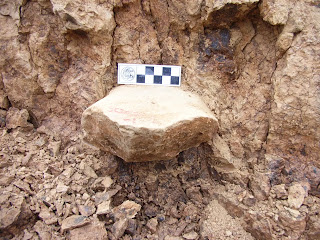 |
Artifact excavated from a layer that is 2.1 million years old. The artifact here is a stone from which three flakes were removed.
Credit: Zhaoyu Zhu |
A recent article on the website
‘Live Science’ reported that researchers in China had excavated stone tools that
were likely made by our human ancestors some 2.12 million years ago. This is the
earliest evidence found so far of our human ancestors outside of Africa.
Archaeologists from China and the
United Kingdom discovered dozens of quartz and quartzite stones at Shangchen,
China, on what is known as the Loess Plateau. The site contains several layers
of loess, which is fine, windblown sediment dating from 1.26 million to 2.12
million years ago.
Hominins, which may have
originated in Africa up to 6 million years ago, include all the species that
emerged after the Homo genus, split from that of chimpanzees. Until
now, the earliest evidence of hominins outside of Africa came from a skeleton and artefacts linked to Homo
erectus and dating to 1.85 million years ago found in the Republic of
Georgia, in 2000. Humans and
chimpanzees are very closely related and separated about 7.4 million years
ago. There is only a 1% difference
between the chimpanzee genome and our own suggesting that we have a common
ancestor.
Among the artefacts excavated was
a stone, from which three flakes were removed, found in a layer that is 2.1
million years old. Paleoanthropologists are excited about the finds because you
don't often find artefacts in their original context. Researchers noticed how
the flaking of the stones was repeated
to create lines in various directions.
Robin Dennell, a
paleoanthropologist at the University of Exeter, pointing out that the Loess
Plateau is a stone-free landscape, states:
"There are no natural processes that could have flaked these
items, so you know that any flaked object could only have been flaked by an
early human."
The presence of these stone tools suggests that human
ancestors left Arica roughly 10,000 generations earlier than previously thought.
However, experts don’t know for sure what species of hominin made the tools. It
is possible that these ancient stone tools were made by Homo erectus, but they could have been made by an even
earlier ancestor.
For further information please see:





No comments:
Post a Comment